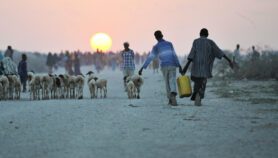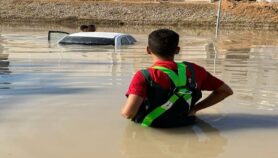By: Dipak Gyawali
Send to a friend
The details you provide on this page will not be used to send unsolicited email, and will not be sold to a 3rd party. See privacy policy.
The Saptakoshi embankment collapse at Kusaha, Nepal, on 18 August was not a natural disaster, but a man-made tragedy, says Dipak Gyawali.
The breached embankment of the Saptakoshi — a transboundary river between India and Nepal, more commonly called the Kosi — has flooded entire districts, damaged infrastructure and left thousands of people homeless in both countries. The catastrophe resulted from an unholy marriage of three things: wrong technological choice, bad institutional arrangements and half a century of political misconduct.
Wrong choices
The Kosi acts as a massive conveyor belt taking sediment from the Himalaya to the Bay of Bengal. Some one hundred million cubic meters of gravel, sand and mud flow out of the Chatara gorge in mountainous Nepal every year. This flow cannot be blamed on deforestation: we have more forest cover in the Kosi catchment today than ever before. It is caused by Himalayan geotectonics coupled with the monsoon regime. As the river slows down in the flat plains beyond, it deposits its sediment, filling up the river’s main channel until it overflows and begins a new course. This natural process produced the large inland delta that lies across southern Nepal and the Indian state of Bihar.
But, for the last half century, the ‘Kosi Project’ has used embankments to restrict the river’s course. This has kept sediment deposits within the main canal, perching the river some four meters above the surrounding land. It was a disaster waiting to happen. Indiscriminate embankment building could never hold back the Kosi’s sediment. The river flow at the time of last month’s breach was not even high. Rather, it was lower than the minimum average flow for August.
And the problem is no longer just the breach site at Kusaha — it is totally uncertain where the new Kosi channel will be in the middle and lower delta in Bihar. The river morphology dynamics must be examined before considering any new embankments or repairs of old ones.
A high dam on the Kosi is not the answer either. It still ignores the primary problem of sedimentation (any reservoir would quickly fill up with Himalayan muck). But quite aside from that, it would take two or more decades to build, be extremely expensive, create social problems by displacing Nepal’s indigenous population and does not consider the problems of seismic activity or the need to divert instantaneous floods during construction. Neither India nor Nepal can afford the technical, economic and social costs associated with a high dam.
New or alternative technologies, suited to an unstable but very fertile flood plain, will have to meet the immediate requirements of Nepal and Bihar. For example, traditional solutions like building houses on stilts and giving villages raised plinths that keep life and property safe (but that allow floodwaters to pass by, leaving fertile silt behind), could be used. Design practices in the transport, housing and agriculture sectors will all need reconsidering.
Mismanagement
Institutional mismanagement must also take its share of the blame for last month’s floods. The Kosi Treaty — signed in 1954 with the aim of controlling summer floods and providing irrigation water in winter — was a neo-colonial treaty forced upon Nepal. It contains institutional irresponsibility at every level.
For example, it gives the Delhi ‘hydrocracy’ total control, naming India responsible for all design, construction, operation and maintenance of the Kosi Project. Nepal cannot order the opening of gates during floods or the supply of irrigation waters during the dry season.
Still, in a tragic and perverse way, this catastrophe has washed away the very foundations of that treaty, bringing calls for the Kosi’s management to be reconsidered in a more sane and equitable manner.
Bad conduct
Any future treaty will also have to deal with another problem — corruption. Back in 1991, an Indian scholar writing in Bombay’s Economic and Political Weekly, estimated that as much as 60 per cent of the 2.5–3 billion rupees spent annually by the Bihar government on construction and repair works was pocketed by politicians, contractors and engineers. It is said there is a perfect system of percentages in which a share exists for everyone who matters, from the minister to the junior engineer. The actual expenditure never exceeds 30 per cent of the budgeted cost. Contractor’s bills are paid without being verified — many of the desiltation and maintenance works allegedly completed are never done at all, and yet payments are made. Indeed, engineers are said to make so much money from the percentages that they do not bother to collect their salaries.
My understanding is that Nepali cadres of ruling political parties got wise to the corruption practiced from across the border and demanded a share. There were, it seems, tough negotiations before the start of this year’s monsoon season, but no agreement had been reached. Kosi officials made no formal approach to the most India-friendly government in power in Nepal because the issue to be resolved was not doing the work, but sharing the booty.
Moving forward
How to move on from here? There are three things that need doing. The Kosi floods are a major humanitarian tragedy that Nepal must address with an open heart, generous pockets and caring hands. The 50,000 or so Nepalis left homeless are, in all probability, permanently displaced since the new Kosi seems unlikely to return to its old channel in the foreseeable future. They must be immediately housed in camps and helped in finding a permanent settlement.
Reconnecting the regions cut off by the new Kosi in eastern Nepal to the rest of the country as soon as possible is also a high priority. This means building a bridge over the Kosi at Chatara and restoring the traffic along major travelling routes, such as the Mahendra highway.
And a serious public review and debate must take place to chart a sane path forward for the Kosi Project. This must be equitable and fair, involving scientists and civic movements in both India and Nepal.
Dipak Gyawali is former Minister for Water Resources in Nepal and head of the Nepal Water Conservation Foundation.













